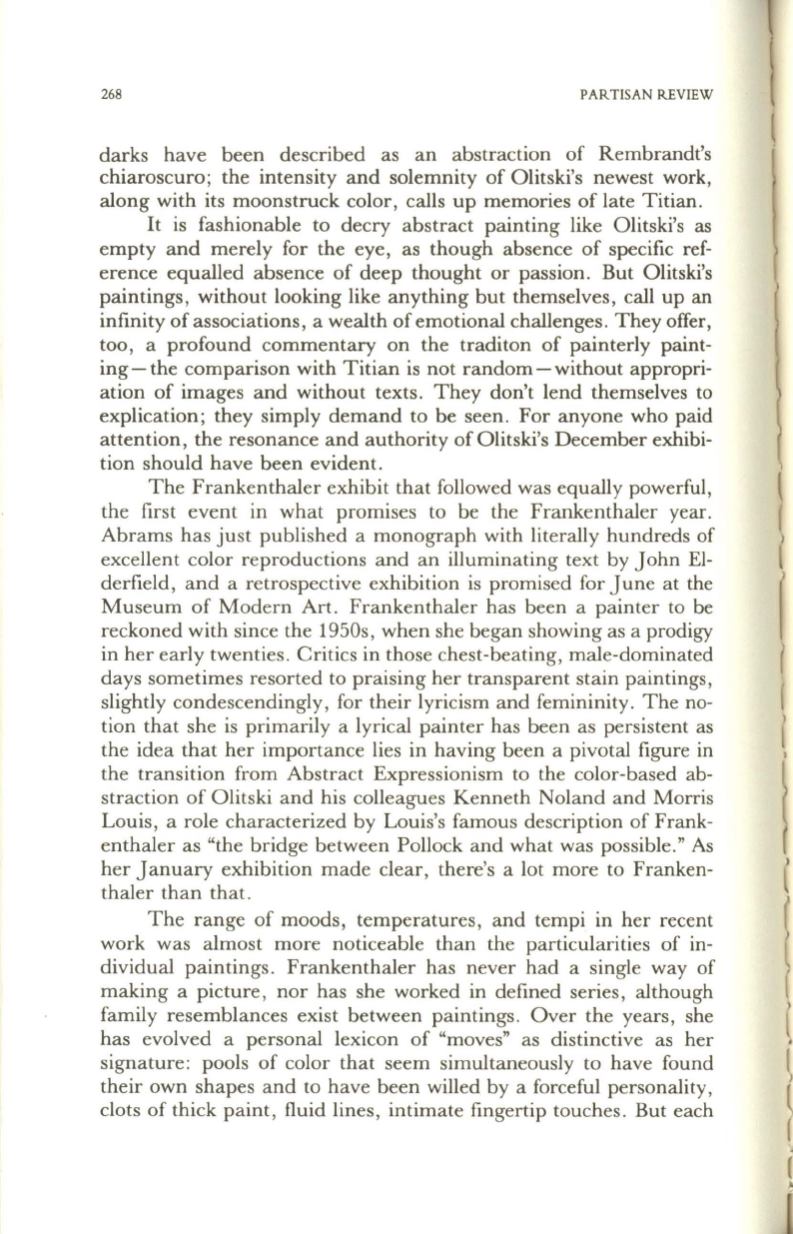
268
PARTISAN REVIEW
darks have been described as an abstraction of Rembrandt's
chiaroscuro; the intensity and solemnity of Olitski's newest work,
along with its moonstruck color, calls up memories of late Titian.
It
is fashionable to decry abstract painting like Olitski's as
empty and merely for the eye, as though absence of specific ref–
erence equalled absence of deep thought or passion. But Olitski's
paintings, without looking like anything but themselves, call up an
infinity of associations, a wealth of emotional challenges. They offer,
too, a profound commentary on the traditon of painterly paint–
ing-the comparison with Titian is not random-without appropri–
ation of images and without texts. They don't lend themselves to
explication; they simply demand to be seen. For anyone who paid
attention, the resonance and authority of Olitski's December exhibi–
tion should have been evident.
The Frankenthaler exhibit that followed was equally powerful,
the first event in what promises to be the Frankenthaler year.
Abrams has just published a monograph with literally hundreds of
excellent color reproductions and an illuminating text by John El–
derfield, and a retrospective exhibition is promised for June at the
Museum of Modern Art. Frankenthaler has been a painter to be
reckoned with since the 1950s, when she began showing as a prodigy
in her early twenties . Critics in those chest-beating, male-dominated
days sometimes resorted to praising her transparent stain paintings,
slightly condescendingly, for their lyricism and femininity . The no–
tion that she is primarily a lyrical painter has been as persistent as
the idea that her importance lies in having been a pivotal figure in
the transition from Abstract Expressionism to the color-based ab–
straction of Olitski and his colleagues Kenneth Noland and Morris
Louis, a role characterized by Louis's famous description of Frank–
enthaler as "the bridge between Pollock and what was possible." As
her January exhibition made clear, there's a lot more to Franken–
thaler than that.
The range of moods, temperatures, and tempi in her recent
work was almost more noticeable than the particularities of in–
dividual paintings . Frankenthaler has never had a single way of
making a picture, nor has she worked in defined series, although
family resemblances exist between paintings. Over the years, she
has evolved a personal lexicon of "moves" as distinctive as her
signature: pools of color that seem simultaneously to have found
their own shapes and to have been willed by a forceful personality,
clots of thick paint, fluid lines, intimate fingertip touches . But each
I
l
l
(
l
r
)
i
I
)
I
r
)
~


